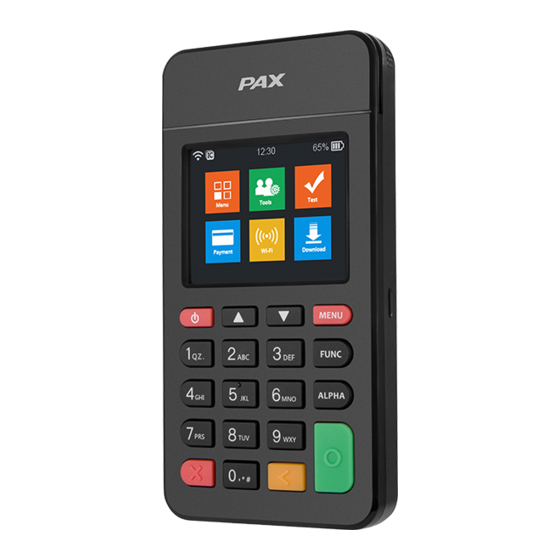
Advertisement
Advertisement
Table of Contents

Summary of Contents for Pax Technology D170
- Page 1 D170 Mini POS PAX TECHNOLOGY LIMITED...
- Page 2 1. Contents Checklist Please check the components after unpacking. If any one of them is missing, or if there is a page missing from the product manual,ect.,please contact the dealer. Name D170 mini POS USB cable Product Manual 2. Product Description Figure 1.Front view...
- Page 3 Figure 3. Diagram of Battery / Battery Cover 9. Nameplate 10. Wireless antenna 11. Beep 12. Battery 13. Double SIM Cards 14. SIM cover tear hand position 3. Installation SIM Card: Remove the SIM card cover. Insert the SIM card to the corresponding card slot. Install the SIM card cover.
- Page 4 Refer to figure above. When swiping card, Please face the magnetic strip of the magnetic card to the inside of the device, Meanwhile, Run the magnetic card across the magnetic chuck slot at a uniform speed, with Two-way swipe; The swiping process should be smooth and uniform. 3) IC card Refer to figure above,When inserting card,The IC card chip should face up.
- Page 5 4) Forbid non-professional to repair the terminal. 5) Strictly forbidden to disassemble and install machines at explosive hazards and use external interface. 6) Should Charge with power adapter. 7) When the battery voltage is too low, insert the power adapter to charge the battery, press the key may hear "DiDi"...
- Page 6 Communications Commission (USA). These requirements set a SAR limit of 1.6 W/kg averaged over one gram of tissue. The highest SAR value reported under this standard during product certification for use when properly worn on the body This device complies with Part 15 of the FCC Rules. Operation is subject to the following two conditions: (1) this device may not cause harmful interference, and (2) this device must accept any interference received, including interference that may cause undesired operation.
















Need help?
Do you have a question about the D170 and is the answer not in the manual?
Questions and answers